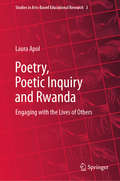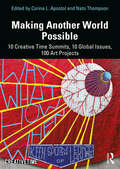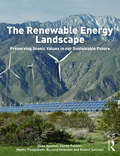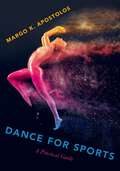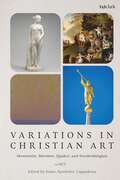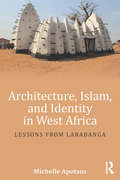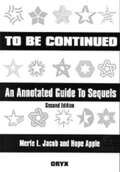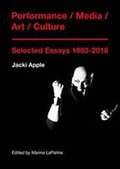- Table View
- List View
The Letters of Philip Webb, Volume III (The Pickering Masters)
by John AplinPhilip Webb was a British architect known as a founder of the Arts and Crafts movement and also a key member of the Pre-Raphaelite circle. He had a long association with William Morris and was responsible for the design of the hugely influential Red House, Morris’s first home. Webb's letters will be of interest to art and architecture historians.
The Letters of Philip Webb, Volume III (The Pickering Masters #2)
by John AplinPhilip Webb was a British architect known as a founder of the Arts and Crafts movement and also a key member of the Pre-Raphaelite circle. He had a long association with William Morris and was responsible for the design of the hugely influential Red House, Morris’s first home. Webb's letters will be of interest to art and architecture historians.
The Letters of Philip Webb, Volume IV (The Pickering Masters)
by John AplinPhilip Webb was a British architect known as a founder of the Arts and Crafts movement and also a key member of the Pre-Raphaelite circle. He had a long association with William Morris and was responsible for the design of the hugely influential Red House, Morris’s first home. Webb's letters will be of interest to art and architecture historians.
The Letters of Philip Webb, Volume IV (The Pickering Masters #2)
by John AplinPhilip Webb was a British architect known as a founder of the Arts and Crafts movement and also a key member of the Pre-Raphaelite circle. He had a long association with William Morris and was responsible for the design of the hugely influential Red House, Morris’s first home. Webb's letters will be of interest to art and architecture historians.
Answers from The Working Actor: Two Backstage Columnists Share Ten Years of Advice
by Jackie Apodaca Michael KostroffFor nearly a decade, Jackie Apodaca and Michael Kostroff shared duties as advice columnists for the actors’ trade paper, Backstage. Their highly popular weekly feature, "The Working Actor," fielded questions from actors all over the country. A cross between "Dear Abby" and The Hollywood Reporter, their column was a fact-based, humorous, compassionate take on the questions actors most wanted answered. Using some of their most interesting, entertaining, and informative columns as launch points, Answers from "The Working Actor" guides readers through the ins and outs (and ups and downs) of the acting industry. Apodaca and Kostroff share an approach that is decidedly "on the ground." They’ve both labored in the trenches just like their readers—dealing with auditions, classes, photos, résumés, rehearsals, contract negotiations, representatives, jobs, challenging colleagues, and the search for that elusive life/career balance. There are few absolutes in the acting profession and virtually no proven and reliable steps. Unlike books that claim to offer "Quick Steps to a Successful Acting Career," Answers from "The Working Actor" deals honestly with the realities, providing facts, options, strategies, stories, points of view, and the wisdom of experience, while ultimately challenging readers to make their own decisions. This book will give new actors a head start on their journeys and remind experienced professionals that, in the acting business, there is never only one answer to any question.
Answers from The Working Actor: Two Backstage Columnists Share Ten Years of Advice
by Jackie Apodaca Michael KostroffFor nearly a decade, Jackie Apodaca and Michael Kostroff shared duties as advice columnists for the actors’ trade paper, Backstage. Their highly popular weekly feature, "The Working Actor," fielded questions from actors all over the country. A cross between "Dear Abby" and The Hollywood Reporter, their column was a fact-based, humorous, compassionate take on the questions actors most wanted answered. Using some of their most interesting, entertaining, and informative columns as launch points, Answers from "The Working Actor" guides readers through the ins and outs (and ups and downs) of the acting industry. Apodaca and Kostroff share an approach that is decidedly "on the ground." They’ve both labored in the trenches just like their readers—dealing with auditions, classes, photos, résumés, rehearsals, contract negotiations, representatives, jobs, challenging colleagues, and the search for that elusive life/career balance. There are few absolutes in the acting profession and virtually no proven and reliable steps. Unlike books that claim to offer "Quick Steps to a Successful Acting Career," Answers from "The Working Actor" deals honestly with the realities, providing facts, options, strategies, stories, points of view, and the wisdom of experience, while ultimately challenging readers to make their own decisions. This book will give new actors a head start on their journeys and remind experienced professionals that, in the acting business, there is never only one answer to any question.
Poetry, Poetic Inquiry and Rwanda: Engaging with the Lives of Others (Studies in Arts-Based Educational Research #3)
by Laura ApolThis book describes the practice of poetic inquiry and takes the reader through the process of translating lived experience into poetry that attends to the lives of others. Using her own writing—from early drafts to published poems—Apol demonstrates elements of poetic inquiry that both give it strength and make it complicated: the importance of craft (the aesthetic); the imperative of accuracy and reliability (the investigative); the significance of ethical responsibility that leads to action (witness); and the centrality of relational connectedness and accountability (withness). Apol raises questions about what it means for poems to function as both research and art, and illustrates what happens when there are irresolvable conflicts between the demands of the poem and a commitment to relationship. Throughout, Apol addresses her white privilege, as well as the dominant white/colonial narrative that often seeps into arts-based work unless it is overtly and critically addressed. The book goes beyond arts-based research, speaking as well to other forms of cross-national, cross-cultural research. It is a call for relational scholarship that moves toward action, a heart-rending teaching, a post-traumatic aesthetic map laid down with clear and poignant theory and praxis to extend, serve and guide.
Making Another World Possible: 10 Creative Time Summits, 10 Global Issues, 100 Art Projects
by Corina L. Apostol Nato ThompsonMaking Another World Possible offers a broad look at an array of socially engaged cultural practices that have become increasingly visible in the past decade, across diverse fields such as visual art, performance, theater, activism, architecture, urban planning, pedagogy, and ecology. Part I of the book introduces the reader to the field of socially engaged art and cultural practice, spanning the past ten years of dynamism and development. Part II presents a visually striking summary of key events from 1945 to the present, offering an expansive view of socially engaged art throughout history, and Part III offers an overview of the current state of the field, elucidating some of the key issues facing practitioners and communities. Finally, Part IV identifies ten global issues and, in turn, documents 100 key artistic projects from around the world to illustrate the various critical, aesthetic and political modes in which artists, cultural workers, and communities are responding to these issues from their specific local contexts. This is a much needed and timely archive that broadens and deepens the conversation on socially engaged art and culture. It includes commissioned essays from noted critics, practitioners, and theorists in the field, as well as key examples that allow insights into methodologies, contextualize the conditions of sites, and broaden the range of what constitutes an engaged culture. Of interest to a wide range of readers, from practitioners and scholars of performance to curators and historians, Making Another World Possible offers both breadth and depth, spanning history and individual works, to offer a unique insight into the field of socially engaged art.
Making Another World Possible: 10 Creative Time Summits, 10 Global Issues, 100 Art Projects
by Corina L. Apostol Nato ThompsonMaking Another World Possible offers a broad look at an array of socially engaged cultural practices that have become increasingly visible in the past decade, across diverse fields such as visual art, performance, theater, activism, architecture, urban planning, pedagogy, and ecology. Part I of the book introduces the reader to the field of socially engaged art and cultural practice, spanning the past ten years of dynamism and development. Part II presents a visually striking summary of key events from 1945 to the present, offering an expansive view of socially engaged art throughout history, and Part III offers an overview of the current state of the field, elucidating some of the key issues facing practitioners and communities. Finally, Part IV identifies ten global issues and, in turn, documents 100 key artistic projects from around the world to illustrate the various critical, aesthetic and political modes in which artists, cultural workers, and communities are responding to these issues from their specific local contexts. This is a much needed and timely archive that broadens and deepens the conversation on socially engaged art and culture. It includes commissioned essays from noted critics, practitioners, and theorists in the field, as well as key examples that allow insights into methodologies, contextualize the conditions of sites, and broaden the range of what constitutes an engaged culture. Of interest to a wide range of readers, from practitioners and scholars of performance to curators and historians, Making Another World Possible offers both breadth and depth, spanning history and individual works, to offer a unique insight into the field of socially engaged art.
The Renewable Energy Landscape: Preserving Scenic Values in our Sustainable Future
by Dean Apostol James Palmer Martin Pasqualetti Richard Smardon Robert SullivanWinner of the 2017 EDRA Great Places Award (Research Category) Winner of the 2017 VT ASLA Chapter Award of Excellence (Communications Category) The Renewable Energy Landscape is a definitive guide to understanding, assessing, avoiding, and minimizing scenic impacts as we transition to a more renewable energy future. It focuses attention, for the first time, on the unique challenges solar, wind, and geothermal energy will create for landscape protection, planning, design, and management. Topics addressed include: Policies aimed at managing scenic impacts from renewable energy development and their social acceptance within North America, Europe and Australia Visual characteristics of energy facilities, including the design and planning techniques for avoiding or mitigating impacts or improving visual fit Methods of assessing visual impacts or energy projects and the best practices for creating and using visual simulations Policy recommendations for political and regulatory bodies. A comprehensive and practical book, The Renewable Energy Landscape is an essential resource for those engaged in planning, designing, or regulating the impacts of these new, critical energy sources, as well as a resource for communities that may be facing the prospect of development in their local landscape.
The Renewable Energy Landscape: Preserving Scenic Values in our Sustainable Future
by Dean Apostol James Palmer Martin Pasqualetti Richard Smardon Robert SullivanWinner of the 2017 EDRA Great Places Award (Research Category) Winner of the 2017 VT ASLA Chapter Award of Excellence (Communications Category) The Renewable Energy Landscape is a definitive guide to understanding, assessing, avoiding, and minimizing scenic impacts as we transition to a more renewable energy future. It focuses attention, for the first time, on the unique challenges solar, wind, and geothermal energy will create for landscape protection, planning, design, and management. Topics addressed include: Policies aimed at managing scenic impacts from renewable energy development and their social acceptance within North America, Europe and Australia Visual characteristics of energy facilities, including the design and planning techniques for avoiding or mitigating impacts or improving visual fit Methods of assessing visual impacts or energy projects and the best practices for creating and using visual simulations Policy recommendations for political and regulatory bodies. A comprehensive and practical book, The Renewable Energy Landscape is an essential resource for those engaged in planning, designing, or regulating the impacts of these new, critical energy sources, as well as a resource for communities that may be facing the prospect of development in their local landscape.
Locating Classical Receptions on Screen: Masks, Echoes, Shadows (The New Antiquity)
by Ricardo Apostol Anastasia BakogianniThis volume explores film and television sources in problematic conversation with classical antiquity, to better understand the nature of artistic reception and classical reception in particular. Drawing inspiration from well-theorized fields like adaptation studies, comparative literature, and film, the essays in this collection raise questions fundamental to the future of reception studies. The first section, ‘Beyond Fidelity’, deals with idiosyncratic adaptations of ancient sources; the second section, ‘Beyond Influence’, discusses modern works purporting to adapt ancient figures or themes that are less straightforwardly ancient than they may at first appear; while the last section, ‘Beyond Original’, uses films that lack even these murky connections to antiquity to challenge the notion that studying reception requires establishing historical connections between works. As questions of audience, interpretation, and subjectivity are central to most contemporary fields of study, this is a collection that is of interest to a wide variety of readers in the humanities.
Dance for Sports: A Practical Guide
by Margo K. ApostolosIn Dance for Sports, author, teacher, dancer, athlete, and researcher Margo Apostolos offers a new training approach for athletes and coaches that synthesizes common techniques between athletics and dance. By utilizing this approach, in- and off-season athletes can improve efficiency and technique. Throughout the book, Apostolos shows the potential exchange between sport and dance in exercises that focus on overlapping physical components of both practices including flexibility, strength, coordination, agility, balance, and timing. She also demonstrates how dance serves sport as a cross training activity with additional opportunities for athletes to explore creativity, improvisation, and mindfulness. Discussion with athletes from several sports interweaves each chapter to expand the learning process and offer useful anecdotes. Based upon the author's decades-long career and extensive experience with athletes and coaches in a variety of sports such as football, basketball, swimming, tennis, track and field and more, Dance for Sports provides a fully integrative guide for students and instructors alike.
DANCE FOR SPORTS C: A Practical Guide
by Margo K. ApostolosIn Dance for Sports, author, teacher, dancer, athlete, and researcher Margo Apostolos offers a new training approach for athletes and coaches that synthesizes common techniques between athletics and dance. By utilizing this approach, in- and off-season athletes can improve efficiency and technique. Throughout the book, Apostolos shows the potential exchange between sport and dance in exercises that focus on overlapping physical components of both practices including flexibility, strength, coordination, agility, balance, and timing. She also demonstrates how dance serves sport as a cross training activity with additional opportunities for athletes to explore creativity, improvisation, and mindfulness. Discussion with athletes from several sports interweaves each chapter to expand the learning process and offer useful anecdotes. Based upon the author's decades-long career and extensive experience with athletes and coaches in a variety of sports such as football, basketball, swimming, tennis, track and field and more, Dance for Sports provides a fully integrative guide for students and instructors alike.
A Guide to Christian Art
by Diane Apostolos-CappadonaA one-volume introduction to and overview of Christian art, from its earliest history to the present day. Diane Apostolos-Cappadona begins by examining how art and Christianity have intersected throughout history, and charts this tumultuous relationship that has yielded some of the greatest outpourings of human creativity. To introduce readers to the way a painting can be read Apostolos-Cappadona begins with an analysis of a painting of the Adoration of the Magi, helping readers to see how they can interpret for themselves the signs, symbols and figures that the book covers.In the more-than 1000 entries that follow Apostolos-Cappadona gives readers an expert overview of all the frequently used symbols and motifs in Christian art as well as the various saints, historical figures, religious events, and biblical scenes most frequently depicted. Readers are introduced to the ways in which religious paintings are often "coded'" such as what a lily means in a picture of Mary, how a goldfinch can be "Christological", or how the presence of an Eagle means it is likely to be a picture of St John. The entries are organized by topic, so that students and beginners can easily find their way to discussion of the themes and motifs they see before them when looking at a painting.
A Guide to Christian Art
by Diane Apostolos-CappadonaA one-volume introduction to and overview of Christian art, from its earliest history to the present day. Diane Apostolos-Cappadona begins by examining how art and Christianity have intersected throughout history, and charts this tumultuous relationship that has yielded some of the greatest outpourings of human creativity. To introduce readers to the way a painting can be read Apostolos-Cappadona begins with an analysis of a painting of the Adoration of the Magi, helping readers to see how they can interpret for themselves the signs, symbols and figures that the book covers.In the more-than 1000 entries that follow Apostolos-Cappadona gives readers an expert overview of all the frequently used symbols and motifs in Christian art as well as the various saints, historical figures, religious events, and biblical scenes most frequently depicted. Readers are introduced to the ways in which religious paintings are often "coded'" such as what a lily means in a picture of Mary, how a goldfinch can be "Christological", or how the presence of an Eagle means it is likely to be a picture of St John. The entries are organized by topic, so that students and beginners can easily find their way to discussion of the themes and motifs they see before them when looking at a painting.
Mary Magdalene: A Visual History
by Diane Apostolos-CappadonaFrom faithful apostle and seductress to feminist icon, Mary Magdalene's many complex roles in Christian history have fascinated us for 2000 years. Illustrated in full colour, this visual history reveals how images and presentations have created a Mary who is often far different from the real woman, the first witness of the Resurrection in the gospels, or even from her appearances in the works of the Church Fathers.Beginning with the earliest sources, uncover who the real Mary was, and what she meant in her own time, before embarking on a fast-paced tour of Magdalene's depictions in great works of art, forgotten masterpieces and contemporary visual culture. Considering relics, statuary, paintings, sculpture and recent works for stage and screen, discover how Mary Magdalene has been seen across time as a witness, a sinner, a penitent, a contemplative, a preacher and a patroness.Above all her complex roles, Mary has emerged as a powerful feminist icon, the closest person to Jesus himself, with a visual history as rich and varied as the roles she has fulfilled in numerous contexts of faith and worship for two millennia.
Mary Magdalene: A Visual History
by Diane Apostolos-CappadonaFrom faithful apostle and seductress to feminist icon, Mary Magdalene's many complex roles in Christian history have fascinated us for 2000 years. Illustrated in full colour, this visual history reveals how images and presentations have created a Mary who is often far different from the real woman, the first witness of the Resurrection in the gospels, or even from her appearances in the works of the Church Fathers.Beginning with the earliest sources, uncover who the real Mary was, and what she meant in her own time, before embarking on a fast-paced tour of Magdalene's depictions in great works of art, forgotten masterpieces and contemporary visual culture. Considering relics, statuary, paintings, sculpture and recent works for stage and screen, discover how Mary Magdalene has been seen across time as a witness, a sinner, a penitent, a contemplative, a preacher and a patroness.Above all her complex roles, Mary has emerged as a powerful feminist icon, the closest person to Jesus himself, with a visual history as rich and varied as the roles she has fulfilled in numerous contexts of faith and worship for two millennia.
Variations in Christian Art: Mennonite, Mormon, Quaker, and Swedenborgian
by Diane Apostolos-CappadonaThe artistic traditions of four major Christian denominations are examined and outlined in detail in this groundbreaking volume that presents the first synthesis of the artistic contributions of those traditions. Diane Apostolos-Cappadona has curated a volume that presents four single-authored contributions in one place, broadening the study of Christian art beyond Roman Catholic, Orthodox and 'protestant' traditions to consider these more recent Christian approaches in close and expert detail. Rachel Epp Buller examines art in the Mennonite tradition, Mormon art is considered by Heather Belnap, Quaker contributions by Rowena Loverance and Swedenborgian art by Diane Apostolos-Cappadona. Each writer presents elements of the theology of their chosen tradition through the prism of the artists and artistic works that they have selected. Alongside mainstream artistic figures such as William Blake less known figures come to the fore and the volume features color illustrations that support and underline the theological and artistic themes presented in each section of the book. Together these studies of artistic presentations in these four traditions will be a much need means of filling a gap in the study of Christian art.
Architecture, Islam, and Identity in West Africa: Lessons from Larabanga
by Michelle ApotsosArchitecture, Islam, and Identity in West Africa shows you the relationship between architecture and Islamic identity in West Africa. The book looks broadly across Muslim West Africa and takes an in-depth study of the village of Larabanga, a small Muslim community in Northern Ghana, to help you see how the built environment encodes cultural history through form, material, and space, creating an architectural narrative that outlines the contours of this distinctive Muslim identity. Apotsos explores how modern technology, heritage, and tourism have increasingly affected the contemporary architectural character of this community, revealing the village’s current state of social, cultural, and spiritual flux. More than 60 black and white images illustrate how architectural components within this setting express the distinctive narratives, value systems, and realities that make up the unique composition of this Afro-Islamic community.
Architecture, Islam, and Identity in West Africa: Lessons from Larabanga
by Michelle ApotsosArchitecture, Islam, and Identity in West Africa shows you the relationship between architecture and Islamic identity in West Africa. The book looks broadly across Muslim West Africa and takes an in-depth study of the village of Larabanga, a small Muslim community in Northern Ghana, to help you see how the built environment encodes cultural history through form, material, and space, creating an architectural narrative that outlines the contours of this distinctive Muslim identity. Apotsos explores how modern technology, heritage, and tourism have increasingly affected the contemporary architectural character of this community, revealing the village’s current state of social, cultural, and spiritual flux. More than 60 black and white images illustrate how architectural components within this setting express the distinctive narratives, value systems, and realities that make up the unique composition of this Afro-Islamic community.
Introducing Postmodernism: A Graphic Guide (Introducing...)
by Richard Appignanesi Chris GarrattWhat connects Marliyn Monroe, Disneyworld, "The Satanic Verses" and cyber space? Answer: Postmodernism. But what exactly is postmodernism? This graphic guide explains clearly the maddeningly enigmatic concept that has been used to define the world's cultural condition over the last three decades. "Introducing Postmodernism" tracks the idea back to its roots by taking a tour of some of the most extreme and exhilarating events, people and thought of the last 100 years: in art - constructivism, conceptual art, Marcel Duchamp, Jackson Pollock and Andy Warhol; in politics and history - McCarthy's witch-hunts, feminism, Francis Fukuyama and the Holocaust; in philosophy - the work of Derrida, Baudrillard, Foucault and Heidegger. The book also explores postmodernism's take on today, and the anxious grip of globalisation, unpredictable terrorism and unforeseen war that greeted the dawn of the 21st century. Regularly controversial, rarely straightforward and seldom easy, postmodernism is nonetheless a thrilling intellectual adventure. "Introducing Postmodernism" is the ideal guide.
To Be Continued: An Annotated Guide to Sequels (Non-ser.)
by Hope Apple Merle L. JacobKeeping track of prolific authors who write fiction series was quite challenging for even the most ardent fan until To Be Continueddebuted in 1995. Noew, readers will be happy that the soon-to-be-released second edition has added 1,600 new books and 400 new series. To Be Continued, Second Edition, maintians the first volume's successful formula that featured concise A-to-Z entries packed with useful information, including titles, publishers, publication dates, genre categories, annotations, and subject terms. Among the genre categories that can be found in To Be Continued are romance, science fiction, crime novel, horror, adventure, fantasy, humor, western, war, Christian fiction, and others.
Performance/media/art/culture (PDF): Selected Essays 1983-2018
by Jacki Apple Marina LaPalmaExperience the interdisciplinary performance scene of the 1980s and beyond through the eyes of one of its most compelling witnesses. Jacki Apple’s Performance / Media / Art / Culture traces performance art, multimedia theatre, audio arts, and dance in the United States from 1983 to the present
Integrated Sustainable Design of Buildings
by Paul ApplebyIntegrated Sustainable Design of Buildings aims to provide a guide to members of design and masterplanning teams on how to deliver sustainable development and buildings cost effectively, meeting current and emerging UK and international statutory and planning requirements. Using a series of case histories and examples from the author's ten years of providing sustainability advisory services the book sets out a clear and understandable strategy that deals with all aspects of sustainable design and construction and the implications for delivery, costs, saleability and long term operation. The extensive scope includes all aspects of environmental, social and economic sustainability, including strategies to reduce carbon emissions and the impact of climate change. Integrated Sustainable Design of Buildings appeared in the Cambridge Top 40 Sustainability Books of 2010.



